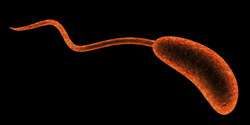Bacterial gene 'therapy' to combat cholera

Cholera is an extremely virulent intestinal infection caused by ingestion of the bacterium Vibrio cholerae (V. cholerae). EU researchers elucidated the molecular mechanisms behind expression of virulence genes with important implications for new therapies.
Cholera causes severe diarrhoea and vomiting and the ensuing dehydration often results in death within hours. Currently, it is treated with a combination of rehydration therapy and antibiotics.
However, a sort of Darwin’s ‘survival of the fittest’ (or most virulent, in this case) takes place, with the bacteria immune to antibiotics surviving to reproduce. The result is a continuous need to develop new therapies to overcome bacterial resistance to existing antibiotics.
Bacteria have a variety of mechanisms to control gene expression via ribonucleic acid (RNA) molecules. V. Cholerae has its own, among them the quorum regulatory RNAs (Qrrs), four small regulatory RNAs (sRNAs) that control expression of virulence genes and thus the cycle of infection.
At the early stage of infection (low cell density in the host), Qrrs are in high number. They bind to specific messenger RNA (mRNA) targets with the help of the RNA binding protein Hfq, leading to expression of virulent genes.
With rising cell density, Qrrs are no longer produced, virulence-gene expression is turned off and the bacteria are released from the host for reinfection.
European researchers supported by funding of the ‘Investigating sRNAs as the master on/off switch of vibrio cholerae virulence’ (VCSRNAHV) project investigated the molecular processes that lead to expression of virulent genes in order to develop ways to inhibit the process and disarm the bacteria.
Cloning the helper molecule Hfq from V. cholerae facilitated elucidation of its molecular structure and identification of mechanisms leading to enhanced resistance to destabilising conditions.
They also determined the ratio or stoichiometry in which Hfq binds to Qrr molecules (one to one), the location of binding on Qrr and changes in the Qrr molecule subsequent to binding. Finally, the team developed a novel assay that enabled determination of preferences in terms of which Qrr bound to which mRNA target.
Cholera is a killer, particularly in developing countries, and its increasing resistance to conventional antibiotics is making its treatment more problematic. The elucidation of molecular mechanisms underlying expression of virulence genes in V. cholerae should have important impact on design of novel and effective therapies.
Provided by CORDIS
















